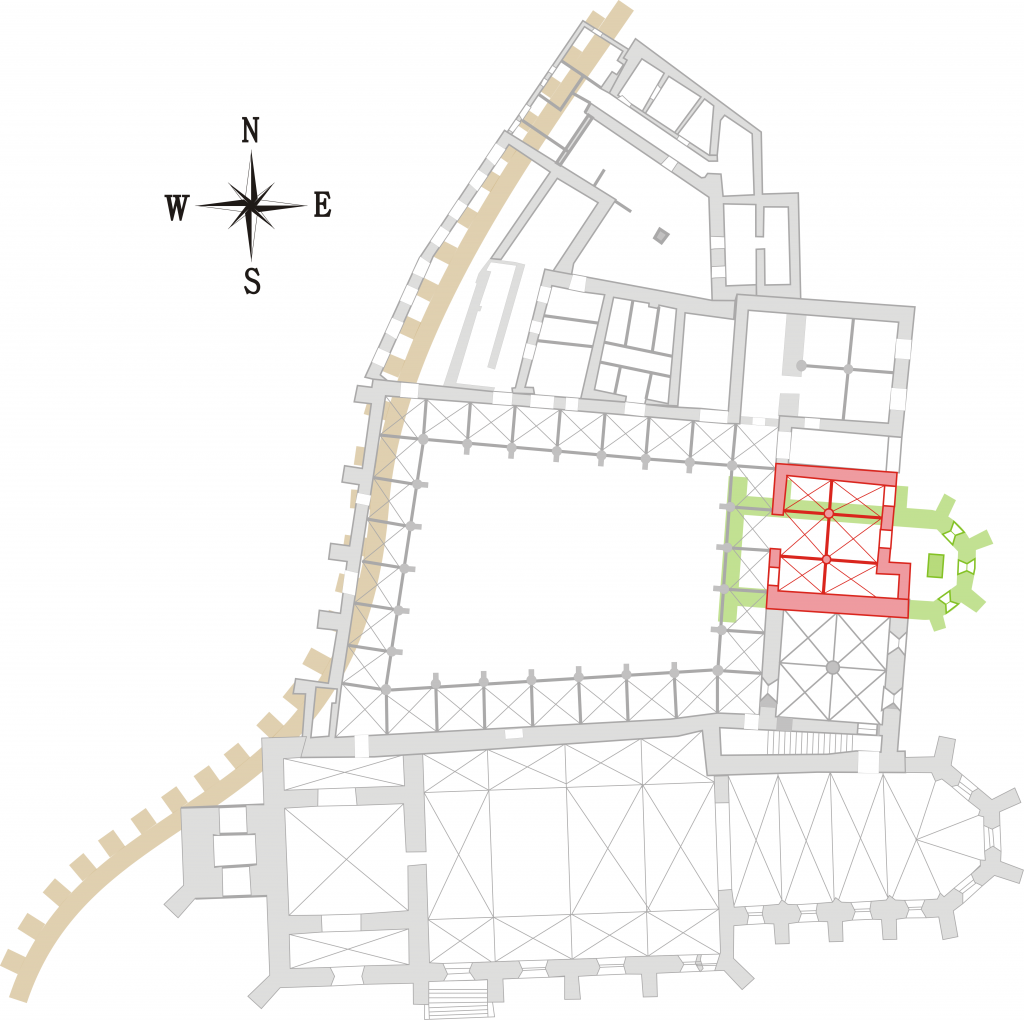Kapitulná sieň
Keď prichádza niekto nový, aby vstúpil do kláštora, nemá sa mu ľahko povoľovať vstup. … Keď potom ten, čo prichádza a vytrvalo klope ukáže, že prijíma s trpezlivosťou príkoria a ťažkosti vstupu, ktoré mu robia, a po štyroch či piatich dňoch trvá na svojej prosbe, nech sa mu dovolí vstúpiť a niekoľko dní zostane v cele hostí. Neskôr vstúpi do cely novicov, kde majú rozjímať, jesť a spať….Ak vytrvá, uvedie sa do vyššie spomínanej cely novicov a opäť sa vo všetkom skúša vo všetkej trpezlivosti. Po uplynutí šiestich mesiacov sa mu znova prečíta Regula, aby vedel, k čomu smeruje. A ak aj naďalej zostane, po štyroch mesiacoch sa mu opäť prečíta tá istá Regula. Ak po zrelej úvahe sľúbi, že bude zachovávať a plniť všetko, čo mu prikážu, vtedy nech je prijatý do spoločenstva. (Regula sv. Benedikta, kap. 58, čl. 1-14, r. okolo r. 547)
Kapitulné siene stredovekých kláštorov dostali svoje pomenovanie podľa kapitúl (capitulum), teda článkov rehoľnej reguly (záväzný predpis o spôsobe života členov konkrétnej rehole), ktoré sa čítali počas konventuálnych liturgických slávení a zasadnutí všetkých členov konventu. Názov zhromaždenia všetkých členov konventu – kapitula – sa u rehoľníkov františkánskej rodiny zachoval dodnes. Opakované čítanie reguly sa netýkalo len kandidátov rehoľného sľubu a novicov. Stalo sa každodennou súčasťou kláštorného života a malo povzbudiť mníchov vo vytrvalosti a vernosti svojim rehoľným sľubom. Súčasťou kapitulnej siene bola menšia kaplnka, prípadne – ako tomu bolo v prípade levočského kláštora – aspoň apsida s oltárom.
Stavba kapitulnej siene levočského kláštora mala dve základné etapy. Pôvodne na tomto mieste stál starší sakrálny objekt – prvotný menší kostol, ktorý bol súčasťou kláštorného provizória po erigovaní kláštora už niekedy koncom 13. storočia. Po rozsiahlej výstavbe jadra kláštora v prvej polovici 14. storočia bol kostol adaptovaný na kapitulnú sieň. Dokončenie výstavby kapitulnej siene, sakristie a refektára kláštora možno datovať do obdobia okolo roku 1380.
Chapter Hall
When anyone is newly come for the reformation of his life, let him not be granted an easy entrance; … If the newcomer, therefore, perseveres in his knocking, and if it is seen after four or five days that he bears patiently the harsh treatment offered him and the difficulty of admission, and that he persists in his petition, then let entrance be granted him, and let him stay in the guest house for a few days. After that let him live in the novitiate, where the novices study, eat and sleep. … If he still stands firm, let him be taken to the above-mentioned novitiate and again tested in all patience. And after the lapse of six months let the Rule be read to him, that he may know on what he is entering. And if he still remains firm, after four months let the same Rule be read to him again. Then, having deliberated with himself, if he promises to keep it in its entirety and to observe everything that is commanded him, let him be received into the community. (Rule of St Benedict, chap. 58, art. 1-14, circa 547)
The chapter halls of medieval monasteries were given their names after the chapters (capitulum), that is the articles of the order’s rule (binding regulation on the way of life of members of a particular order), which were read during convent liturgical celebrations and meetings of all members of the convent. The name of the assembly of all members of the convent – the chapter – has been preserved among the monks of the Franciscan family to nowadays. Repeated readings of the rule did not concern only candidates of religious vows and novices. It became an everyday part of monastic life and should have encourage monks in perseverance and faithfulness with their religious vows. Part of the chapter hall was a smaller chapel, or – as in the case of the Levoča monastery – at least an apse with an altar.
The construction of the chapter hall of the Levoča monastery had two basic stages. Originally, an older sacral building stood on this site – the first smaller church, which was part of the monastery’s temporary building after the erection of the monastery sometime at the end of the 13th century. After extensive construction of the monastery core in the first half of the 14th century, the church was adapted into a chapter hall. The completion of the construction of the chapter hall, sacristy and refectory of the monastery can be dated to the period around 1380.

